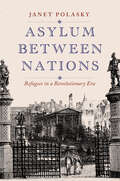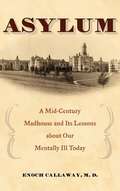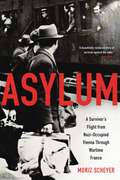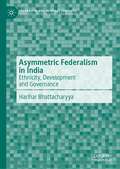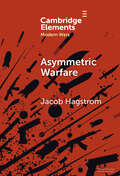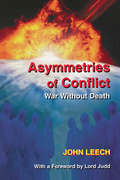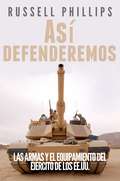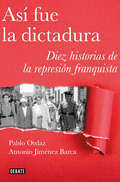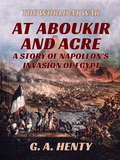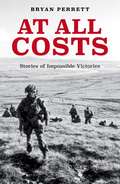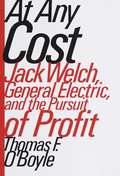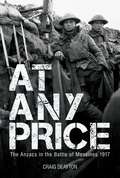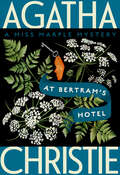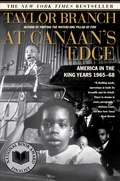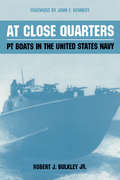- Table View
- List View
Asylum between Nations: Refugees in a Revolutionary Era
by Janet PolaskyWhy some of the most vulnerable communities in Europe, from independent cities to new monarchies, welcomed refugees during the Age of Revolutions and prospered &“Janet Polasky unearths an unappreciated history of the experience of asylum in Europe and the United States since the Age of the Democratic Revolutions. Facing squarely the destruction of asylum in our own time, she ends with a stunningly optimistic vision of a path toward its reconstruction.&”—Linda K. Kerber, author of No Constitutional Right to Be Ladies Driven from their homelands, refugees from ancient times to the present have sought asylum in worlds turned upside down. Theirs is an age‑old story. So too are the solutions to their plight. In the wake of the American and French Revolutions, thousands of men and women took to the roads and waterways on both sides of the Atlantic—refugees in search of their inalienable rights. Although larger nations fortified their borders and circumscribed citizenship, two port cities, German Hamburg and Danish Altona, opened their doors, as did the federated Swiss cantons and the newly independent Belgian monarchy. The refugees thrived and the societies that harbored them prospered. The United States followed, not only welcoming waves of immigrants in the mid‑nineteenth century but offering them citizenship as well. In this remarkable story of the first modern refugee crisis, historian Janet Polasky shows how open doors can be a viable alternative to the building of border walls.
Asylum: A Mid-Century Madhouse and Its Lessons about Our Mentally ill Today
by Enoch CallawayIn his witty and warm history of the facility founded in 1833, Callaway reflects not just on the events in this fortress-like place, but also how those events parallel advances and failures in the field of psychiatry itself.
Asylum: A Survivor's Flight from Nazi-Occupied Vienna Through Wartime France
by P. N. Singer Moriz ScheyerA recently discovered account of an Austrian Jewish writer's flight, persecution, and clandestine life in wartime France.As arts editor for one of Vienna's principal newspapers, Moriz Scheyer knew many of the city's foremost artists, and was an important literary journalist. With the advent of the Nazis he was forced from both job and home. In 1943, in hiding in France, Scheyer began drafting what was to become this book. Tracing events from the Anschluss in Vienna, through life in Paris and unoccupied France, including a period in a French concentration camp, contact with the Resistance, and clandestine life in a convent caring for mentally disabled women, he gives an extraordinarily vivid account of the events and experience of persecution. After Scheyer's death in 1949, his stepson, disliking the book's anti-German rhetoric, destroyed the manuscript. Or thought he did. Recently, a carbon copy was found in the family's attic by P.N. Singer, Scheyer's step-grandson, who has translated and provided an epilogue.
Asymmetric Federalism in India: Ethnicity, Development and Governance (Federalism and Internal Conflicts)
by Harihar BhattacharyyaThis book provides a critical account of federal asymmetry in India - its origins, context, forms and functioning - by taking into account the institutional effectiveness of asymmetric institutions in the regions for identity fulfillment, development and governance. It argues that while some asymmetry, de jure/ or de facto, is part of all federations for meeting some special circumstances, in India, which has followed a different path of federation building, asymmetric institutional solutions especially in the border areas have played a crucially important role in accommodating ethno-cultural diversity, ensuring law and order, a level of development and governance in a process that has turned the ‘rebels into stakeholders’. India’s federal asymmetric designs and their working has been a key to holding the peripheries within the Union of India. The book utilizes both archival research and empirical survey data, as well as elite interviews.
Asymmetric Warfare in South Asia: The Causes and Consequences of the Kargil Conflict
by Peter R. LavoyThe 1999 conflict between India and Pakistan near the town of Kargil in contested Kashmir was the first military clash between two nuclear-armed powers since the 1969 Sino-Soviet war. Kargil was a landmark event not because of its duration or casualties, but because it contained a very real risk of nuclear escalation. Until the Kargil conflict, academic and policy debates over nuclear deterrence and proliferation occurred largely on the theoretical level. This deep analysis of the conflict offers scholars and policymakers a rare account of how nuclear-armed states interact during military crisis. Written by analysts from India, Pakistan, and the United States, this unique book draws extensively on primary sources, including unprecedented access to Indian, Pakistani, and U. S. government officials and military officers who were actively involved in the conflict. This is the first rigorous and objective account of the causes, conduct, and consequences of the Kargil conflict.
Asymmetric Warfare: Politics and Cultures of Violence in the Modern Era (Elements in Modern Wars)
by Jacob HagstromThe forces that fight asymmetric wars are so distinct that one side avoids direct military confrontation in favor of political, social, or otherwise unorthodox means of resistance. These conflicts have been a mainstay of modern times, though scholars have often separated them into various designations by era. Observers have referred, in chronological order, to Indian warfare, petite guerre (small war), guerrilla warfare, irregular or revolutionary war, and terrorism. The proliferation of labels over time has obscured the continuity of asymmetric wars throughout modernity. Stark distinctions in resources and capabilities have shaped the reasons why states and societies have decided to fight, and the manner in which they have fought. Across the modern era, mismatches arose in the domains of technology, intelligence production, and law. But in recent decades, so-called weak powers have neutralized many of the typical advantages of strong military states.
Asymmetrical Warfare On The Great Plains: A Review Of The American Indian Wars-1865-1891
by Lieutenant Colonel Lowell Steven YarbroughThe American Indian policy, formulated at the turn of the 19th century, significantly impacted the national military strategy. President Jefferson's plan for Indian removal became the cornerstone for federal policy. Congress would bear the responsibility for crafting the nation's Indian policies, but the burden for execution was left to an unprepared and undermanned Army.From the end of the Civil War to the beginning of the Spanish-American War in 1898, the principal mission of the Army was fighting Indians. Returning to the Western frontier the Army attempted to fight the Indians using the tactics that proved successful in the Civil War. The diverse Great Plains tribes, using raids and ambushes, successfully fought a thirty-year war against a superior military force. It would finally take the unorthodox tactics of several field commanders to bring an end to the fighting.This paper examines the national policy and the means used to implement it. The paper examines asymmetrical warfare through its discussion on critical shortcomings in military preparedness and strategy. The past several conflicts that U.S. military forces have participated in (Somalia, Haiti, Bosnia, Kosovo, and Afghanistan) suggest that the American Indian Wars offer valuable strategic lessons.
Asymmetries of Conflict: War Without Death
by John LeechDecisions about defence and security are becoming increasingly open to public influence. This book therefore aims to give both the voter and the decision maker a new vision of how to manage crises and avert hostilities with non-traditional means.
Asymmetry and Markedness Theory I: Affirmation and Negation (Chinese Linguistics)
by Shen JiaxuanThis first volume explores asymmetry in language by examining how affirmative and negative constructions reveal markedness phenomena.Building on the focus of the larger set, this volume first introduces the theoretical framework and key concepts of markedness theory and then applies them to affirmation-negation dynamics. It discusses unmarked versus marked negation, polarity words, and the gradual weakening of affirmative-negative contrasts, showing how these patterns reflect deeper connections between language, cognition, and semantics.This volume will benefit linguists, language educators, and researchers interested in language structure and function, particularly in Chinese linguistics, markedness theory, and cross-linguistic inquiry.
Asymmetry and Markedness Theory II: Form and Meaning (Chinese Linguistics)
by Shen JiaxuanThis second volume examines asymmetry in language by focusing on how linguistic form and meaning align or diverge.Building on the concepts introduced in Volume 1, this volume analyzes symmetry and asymmetry in form-meaning relations using examples from antonym pairs, subject-object contrasts, and the markedness patterns of adjectives. It integrates several linguistic levels, emphasizing how functional and cognitive factors drive these phenomena. The concluding discussion posits that asymmetry persists as a core feature of language, whereas symmetry is conditional and transient.This volume will appeal to linguists, language educators, and anyone seeking deeper insights into linguistic structure and function, particularly in Chinese linguistics, markedness research, and comparative language studies.
Así defenderemos: Las armas y el equipamiento del Ejército de los EE.UU.
by Russell Phillips Pablo G. RomeroUna descripción detallada y exhaustiva de las armas y equipos del Ejército de los Estados Unidos de América.
Así fue la dictadura: Diez historias de la represión franquista
by Antonio Jiménez Barca Pablo OrdazPablo Ordaz y Antonio Jiménez Barca abordan, a través de 10 relatos testimoniales, uno de los temas pendientes de la historia de nuestro país: las víctimas del franquismo. Este libro se compone de diez voces que relatan cómo era vivir bajo la dictadura de Franco. Domingo Malagón fue un exiliado comunista con vocación de pintor que pasó 40 años falsificando carnés para sus compañeros; Víctor Díaz-Cardiel fue detenido y encarcelado por organizar una huelga en Villaverde; Federico Armenteros, profesor homosexual, vio cómo un régimen brutal y retrógrado le torcía la vida para siempre. Por estas páginas desfilan perfiles de mujeres activistas que malvivían con sus derechos recortados, de intelectuales acostumbrados a sortear la censura o de jornaleros andaluces que a su condición de explotados añadían la de amordazados. El conjunto compone un retrato, no completo, pero sí representativo y directo, de cómo era vivir con Franco, algo que, tras 40 años, muchos parecen haber olvidado.
Así los trata la muerte: Voces desde el cementerio de la Recoleta
by María Rosa LojoRelatos que recrean historias de personajes enterrados en el Cementerio de la Recoleta, como Lucio V. Mansilla, Mariquita Sánchez de Thompson, Camila O'Gorman y Dominguito Sarmiento. Después del éxito de Historias ocultas en la Recoleta, María Rosa Lojo vuelve con más relatos sobre algunos de los personajes enterrados en el cementerio más famoso del país. Nos cuenta no sólo cómo fueron sus vidas en la tierra, sino cómo los trata la muerte, en el trasmundo que supieron conseguir. Asistiremos a sus andanzas y sorprendentes encuentros. Lucio V. Mansilla dialoga con Manuel, su valet, dos desorientados fantasmas a fines del siglo XX; su hermana, la escritora Eduarda Mansilla, viaja otra vez a los Estados Unidos, pero descubre el país de Donald Trump; Mariquita Sánchez de Thompson sigue enviándole cartas a su hija Florencia; José María Calaza, célebre jefe de bomberos de Buenos Aires, visita el Infierno para conocer al emperador Nerón. Sabremos de Victoria Ocampo, Camila O'Gorman, Dominguito Sarmiento y el médico Polidoro Segers, testigo de la masacre de los selk'nam en Tierra del Fuego. Entre el sueño y la realidad, entre la vida y la muerte, entre lo documentado y lo fantaseado, los cuentos de María Rosa Lojo respiran luminosidad y delicadeza, humor e inteligencia. Relatos donde seguimos oyendo las voces de muertos que tienen mucho para decirnos, tanto de la historia argentina como de la condición humana. La crítica ha dicho sobre la autora y su obra: «Una de las voces más originales y convincentes de la literatura hispanoamericana actual.»Corriere Della Sera «Sin duda, Lojo es una maestra en el arte de cruzar la historia personal con la colectiva.»Mónica López Ocón, Tiempo Argentino «Escritora lúcida y prolífica, de gran talento literario, ha trazado una de las trayectorias más éticas de nuestras Letras.»Marcela Crespo Buiturón «Una brillante contadora de historias.»Antonio Requeni, La Nación «...Una muestra de que se puede tratar la Historia, libre de cánones convencionales.»Alejandro Lorenzo, El Nuevo Herald, Miami
At Aboukir and Acre - A Story of Napoleon's Invasion of Egypt: A Story Of Napoleon's Invasion Of Egypt (The World At War)
by G. A. HentyAs a result of those two losses, Napoleon was trapped. At Aboukir and Acre is the story of Edgar Blagrove, a young man whose father was an English merchant in Alexandria. (Google)
At All Costs
by Bryan PerrettFrom the jaws of defeat, incredible victories.AT ALL COSTS! transports you to the battlefront for over two centuries of astonishing military confrontations. From the Battle of Minden in 1795 to dramatic second world war stories and the Battle for Goose Green in the Falklands, Bryan Perrett gives astoundingly vivid accounts of international forces in daring actions, achieving victory against the odds.These real-life military adventures are meticulously, accurately described, giving a true flavour of some of the most important moments in world history.
At All Costs
by Bryan PerrettFrom the jaws of defeat, incredible victories.AT ALL COSTS! transports you to the battlefront for over two centuries of astonishing military confrontations. From the Battle of Minden in 1795 to dramatic second world war stories and the Battle for Goose Green in the Falklands, Bryan Perrett gives astoundingly vivid accounts of international forces in daring actions, achieving victory against the odds.These real-life military adventures are meticulously, accurately described, giving a true flavour of some of the most important moments in world history.
At All Costs: Stories Of Impossible Victories (Cassell Military Classics Ser.)
by Bryan PerrettFrom the jaws of defeat, incredible victories.
At America's Gates
by Erika LeeWith the Chinese Exclusion Act of 1882, Chinese laborers became the first group in American history to be excluded from the United States on the basis of their race and class. This landmark law changed the course of U.S. immigration history, but we know little about its consequences for the Chinese in America or for the United States as a nation of immigrants. At America's Gates is the first book devoted entirely to both Chinese immigrants and the American immigration officials who sought to keep them out. Erika Lee explores how Chinese exclusion laws not only transformed Chinese American lives, immigration patterns, identities, and families but also recast the United States into a "gatekeeping nation." Immigrant identification, border enforcement, surveillance, and deportation policies were extended far beyond any controls that had existed in the United States before. Drawing on a rich trove of historical sources--including recently released immigration records, oral histories, interviews, and letters--Lee brings alive the forgotten journeys, secrets, hardships, and triumphs of Chinese immigrants. Her timely book exposes the legacy of Chinese exclusion in current American immigration control and race relations.
At Any Cost: Jack Welch, General Electric, and the Pursuit of Profit
by Thomas F. O'Boyletells the story of Jack Welch's ruthless remaking of GE and the cost to humans and the environment which are largely ignored by Welch's admirers. An excellent read.
At Any Cost: Jack Welch, General Electric, and the Pursuit of Profit
by Thomas F. O'Boyle"O'Boyle has researched and written a monumental book that should be mandatory reading for all CEOs and anyone concerned with business ethics." --The Philadelphia Inquirer"Superb . . . a spirited study of General Electric, and of its sometimes brilliant, sometimes bungling, but always ruthless boss, Jack Welch." --Chicago Sun-TimesWith convincing passion and meticulous research, Thomas F. O'Boyle explores the forces behind General Electric's rise to the top of Wall Street, questioning if GE, with chief executive officer Jack Welch at the helm, is still "bringing good things to life." Welch--explosive, profit-hungry, and pragmatic--catapulted GE's stocks to the top, up 1,155 percent from 1982 to 1997. O'Boyle argues that these astounding results have come only with the heavy price of employees' lives, blighted under the tyranny of "Neutron Jack" Welch, so named for his bomb-like ability to eliminate staff without disturbing surrounding operations. During Welch's reign, hard-nosed success tactics--unblinking downsizing, ruthless acquisition negotiations, and the virtual abandonment of manufacturing in favor of the more glamorous entertainment and financial services industries--coexist with scandals like price-fixing, pollution, and defense contract fraud. Sure to spark controversy, this gripping, comprehensive account begs the greater question: Is Jack Welch's GE a model company for business in the next century, or is it time to change the way the world does business? "Smoothly written and thoroughly researched." --USA Today"This book makes a valuable contribution to our understanding of corporate America. . . . Thomas F. O'Boyle persuades you that GE--Jack Welch's GE--brings bad things to life. In abundance." --Washington MonthlyFrom the Trade Paperback edition.
At Any Price: The ANZACS at the Battle of Messines 1917
by Craig DeaytonThe enemy must not get the Messines Ridge at any price… So read the orders to German troops defending the vital high ground south of Ypres. On 7 June 1917, the British Second Army launched its attack with an opening like no other. In the largest secret operation of the First World War, British and Commonwealth mining companies placed over a million pounds of explosive beneath the German front-line positions in 19 giant mines which erupted like a volcano. This was just the beginning. By the end of that brilliant summer&’s day, one of the strongest positions on the Western Front had fallen in the greatest British victory in three long years of war. For the ANZACs, who comprised one third of the triumphant Second Army, it was their most significant achievement to that point; for the men of the New Zealand Division, it would be their finest hour. It is difficult to overstate the importance of Messines for the Australians, whose first two years of war had represented an almost unending catalogue of disaster. This was both the first real victory for the AIF and the first test in senior command for Major General John Monash, who commanded the newly formed 3rd Division. Messines was a baptism of fire for the 3rd Division which came into the line alongside the battle-scarred 4th Australian Division, badly mauled at Bullecourt just six weeks earlier. The fighting at Messines would descend into unimaginable savagery, a lethal and sometimes hand-to-hand affair of bayonets, clubs, bombs and incessant machine-gun fire, described by one Australian as &‘72 hours of Hell&’. After their string of bloody defeats over 1915 and 1916, Messines would prove the ultimate test for the Australians.
At Bertram's Hotel: A Miss Marple Mystery (Miss Marple Mysteries #10)
by Agatha ChristieAt Bertram’s Hotel the intrepid Miss Marple, on holiday in London, must solve a deadly mystery at the end of a chain of very violent events.An old-fashioned London hotel is not quite as reputable as it makes out to be.…When Miss Marple comes up from the country for a holiday in London, she finds what she’s looking for at Bertram’s Hotel: traditional decor, impeccable service, and an unmistakable atmosphere of danger behind the highly-polished veneer. Yet, not even Miss Marple can foresee the violent chain of events set in motion when an eccentric guest makes his way to the airport on the wrong day.…
At Canaan's Edge: America in the King Years, 1965-68
by Taylor Branch<P>At Canaan's Edge concludes America in the King Years, a three-volume history that will endure as a masterpiece of storytelling on American race, violence, and democracy. Pulitzer Prize-winner and bestselling author Taylor Branch makes clear in this magisterial account of the civil rights movement that Martin Luther King, Jr., earned a place next to James Madison and Abraham Lincoln in the pantheon of American history. <P>In At Canaan's Edge, King and his movement stand at the zenith of America's defining story, one decade into an epic struggle for the promises of democracy. Branch opens with the authorities' violent suppression of a voting-rights march in Alabama on March 7, 1965. The quest to cross Selma's Edmund Pettus Bridge engages the conscience of the world, strains the civil rights coalition, and embroils King in negotiations with all three branches of the U.S. government. <P>The marches from Selma coincide with the first landing of large U.S. combat units in South Vietnam. The escalation of the war severs the cooperation of King and President Lyndon Johnson after a collaboration that culminated in the landmark 1965 Voting Rights Act. <P>After Selma, young pilgrims led by Stokely Carmichael take the movement into adjacent Lowndes County, Alabama, where not a single member of the black majority has tried to vote in the twentieth century. Freedom workers are murdered, but sharecroppers learn to read, dare to vote, and build their own political party. Carmichael leaves in frustration to proclaim his famous black power doctrine, taking the local panther ballot symbol to become an icon of armed rebellion. <P>Also after Selma, King takes nonviolence into Northern urban ghettoes. Integrated marches through Chicago expose hatreds and fears no less virulent than the Mississippi Klan's, but King's 1966 settlement with Mayor Richard Daley does not gain the kind of national response that generated victories from Birmingham and Selma. We watch King overrule his advisers to bring all his eloquence into dissent from the Vietnam War. We watch King make an embattled decision to concentrate his next campaign on a positive compact to address poverty. <P>We reach Memphis, the garbage workers' strike, and King's assassination. Parting the Waters provided an unsurpassed portrait of King's rise to greatness, beginning with the 1955 Montgomery bus boycott and ending with the assassination of President John F. Kennedy in 1963. In Pillar of Fire, theologians and college students braved the dangerous Mississippi Freedom Summer of 1964 as Malcolm X raised a militant new voice for racial separatism. <P>The Civil Rights Act of 1964 outlawed segregation by race and mandated equal opportunity for women. From the pinnacle of winning the Nobel Peace Prize, King willed himself back to "the valley" of jail in his daunting Selma campaign. At Canaan's Edge portrays King at the height of his moral power even as his worldly power is waning. It shows why his fidelity to freedom and nonviolence makes him a defining figure long beyond his brilliant life and violent end.
At Close Quarters
by Robert J. BulkleySmall though they were, PT boats played a key role in World War II, carrying out an astonishing variety of missions where fast, versatile, and strongly armed vessels were needed. Called "weapons of opportunity," they met the enemy at closer quarters and with greater frequency than any other type of surface craft. Among the most famous PT commanders was John F. Kennedy, whose courageous actions in the Pacific are now well known to the American public. The author of the book, another distinguished PT boat commander in the Pacific, compiled this history of PT-boat operations in World War II for the U.S. Navy shortly after V-J Day, when memories were fresh and records easily assessable. The book was first made available to the public in 1962 after Kennedy's inauguration as president of the United States interest in PTs was at a peak.Bulkley provides a wealth of facts about these motor torpedo boats, whose vast range of operation covered two oceans as well as the Mediterranean and the English Channel. Although their primary mission was to attack surface ships and craft close to shore, they were also used effectively to lay mines and smoke screens, to rescue downed aviators, and to carry out intelligence and raider operations. The author gives special attention to the crews, paying well-deserved tribute to their heroism, skill, and sacrifice that helped to win the war.
At Close Quarters; PT Boats In The United States Navy [Illustrated Edition]
by Rear Admiral Earnest McNeill Eller President John F. Kennedy Captain Robert J. Bulkley Jr.Includes over 110 illustrations charting the history of the US Navy PT Boats."The destiny of our country has been inextricably interwoven with the sea. This was never more true than in the giant World War II that involved all seas and most of mankind. To fight the sea war we needed many types of ships, large and small, from aircraft carriers and battleships to PT boats."Small though they were, the PT boats played a key role. Like most naval ships, they could carry out numerous tasks with dispatch and versatility. In narrow waters or in-fighting close to land they could deliver a powerful punch with torpedo or gun. On occasion they could lay mines or drop depth charges. They could speed through reefs and shark infested waters to rescue downed pilots or secretly close the shore to make contacts with coast watchers and guerrilla forces. PT boats were an embodiment of John Paul Jones' words:"I wish to have no connection with any ship that does not sail fast for I intend to go in harm's way.""Naval strength must function from shore to shore and on inland waters where the mobility and flexibility provided by ships can be employed to support land operations. PT boats filled an important need in World War II in shallow waters, complementing the achievements of greater ships in greater seas. This need for small, fast, versatile, strongly armed vessels does not wane. In fact it may increase in these troubled times when operations requiring just these capabilities are the most likely of those which may confront us."The thorough and competent account herein of over-all PT boat operations in World War II, compiled by Captain Robert Bulkley, a distinguished PT boat commander, should therefore prove of wide interest. The widest use of the sea, integrated fully into our national strength, is as important to America in the age of nuclear power and space travel as in those stirring days of the birth of the Republic."-President John F Kennedy.
